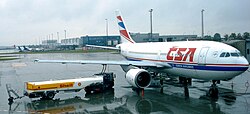
Back وقود النفاثات Arabic سوخت جت AZB Combustible per a reactors Catalan Kerosin German Combustible de turbina de aviación Spanish Õhusõiduki kütus Estonian سوخت جت Persian Kerosine Frisian Kerozin Croatian Bahan bakar jet ID
 | |
| Identifiers | |
|---|---|
| |
| ChemSpider |
|
| UNII | |
CompTox Dashboard (EPA)
|
|
| Properties | |
| Appearance | Straw-colored liquid |
| Density | 775-840 g/L |
| Melting point | −47 °C (−53 °F; 226 K) |
| Boiling point | 176 °C (349 °F; 449 K) |
| Hazards | |
| NFPA 704 (fire diamond) | |
| Flash point | 38 °C (100 °F; 311 K) |
| 210 °C (410 °F; 483 K) | |
| Safety data sheet (SDS) | [1] [2] |
Except where otherwise noted, data are given for materials in their standard state (at 25 °C [77 °F], 100 kPa).
| |
Jet fuel or aviation turbine fuel (ATF, also abbreviated avtur) is a type of aviation fuel designed for use in aircraft powered by gas-turbine engines. It is colorless to straw-colored in appearance. The most commonly used fuels for commercial aviation are Jet A and Jet A-1, which are produced to a standardized international specification. The only other jet fuel commonly used in civilian turbine-engine powered aviation is Jet B, which is used for its enhanced cold-weather performance.
Jet fuel is a mixture of a variety of hydrocarbons. Because the exact composition of jet fuel varies widely based on petroleum source, it is impossible to define jet fuel as a ratio of specific hydrocarbons. Jet fuel is therefore defined as a performance specification rather than a chemical compound.[1] Furthermore, the range of molecular mass between hydrocarbons (or different carbon numbers) is defined by the requirements for the product, such as the freezing point or smoke point. Kerosene-type jet fuel (including Jet A and Jet A-1, JP-5, and JP-8) has a carbon number distribution between about 8 and 16 (carbon atoms per molecule); wide-cut or naphtha-type jet fuel (including Jet B and JP-4), between about 5 and 15.[2][3]
- ^ Defence Standards. "Ministry of Defence Standard 91-91: Turbine Fuel, Kerosine Type, Jet A-1" (PDF). p. 1. Archived from the original (PDF) on 2022-03-07. Retrieved 2019-01-27.
- ^ Chevron Products Corporation. "Aviation Fuels Technical Review" (PDF). Archived from the original (PDF) on 2015-09-07. Retrieved 2014-05-06.
- ^ Salvatore J. Rand (ed), Significance of Tests for Petroleum Products (8th Edition) ASTM International, 2010, ISBN 978-1-61583-673-4 page 88
© MMXXIII Rich X Search. We shall prevail. All rights reserved. Rich X Search
